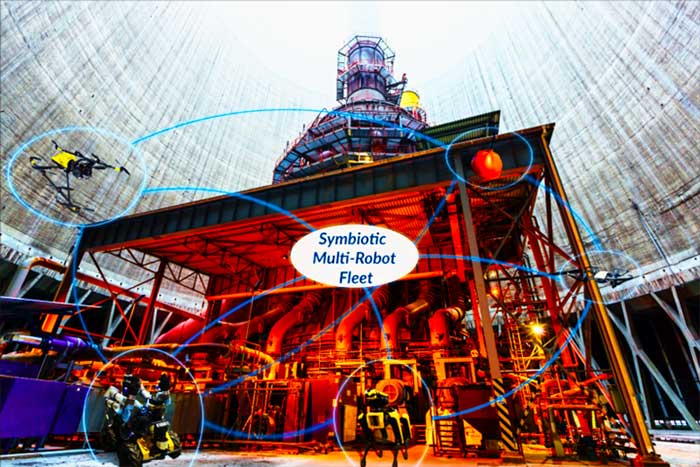This autonomous robot team can replace humans in performing many dangerous tasks such as cleaning up decommissioned nuclear power plants or responding to incidents like explosions.
International scientists have recently unveiled a highly advanced automated robot system officially named Symbiotic Multi-Robot Fleet (SMuRF) to assist in cleanup operations in decommissioned, degraded, or explosion-affected nuclear facilities.
The SMuRF System has been developed by engineers from the University of Glasgow, the University of Manchester, the Bristol Robotics Laboratory, and Heriot-Watt University, all based in the United Kingdom.

SMuRF can provide faster and safer monitoring methods for nuclear facilities. (Photo: University of Glasgow)
Daniel Mitchell, a co-author of the new research, stated: “Each robot we program and design in this SMuRF prototype has its own capabilities and limitations, as well as its own operating system. It includes types of aerial, rolling, or walking robots, in the form of wheeled robots, quadrupeds, and aerial vehicles.”
According to Daniel Mitchell, these robots can work together to complete tasks that are difficult or dangerous for humans, especially in radioactive environments.
In a live demonstration at the Robotics and Artificial Intelligence Collaboration Facility (RAICo) in Cumbria, researchers showcased how SMuRF successfully completed inspection tasks in a simulated radioactive storage facility.
The collaboration capabilities of the robots in SMuRF stem from a sophisticated cyber-physical system (CPS), developed by researchers, which allows the robots to communicate with each other in real-time using up to 1,600 integrated operational sensors.
The robots worked together to create a 3D digital map of the simulated radioactive storage area using their specialized sensors. An aerial robot operated remotely also contributed to the mapping process.
Boston Dynamics Spot Robot utilized its flexible arm to produce tools for closer observation in the area. Other wheeled robots, named Scout and CARMA, measured radiation levels in the testing area. Notably, CARMA detected a simulated radioactive liquid spill under a barrel, which is crucial for ensuring it can proactively clean up radioactive liquids properly in real-world scenarios.
This groundbreaking technology holds potential not only for cleaning up decommissioned nuclear power plants, responding to explosions or radioactive leaks but also significantly aids maintenance in challenging environments such as offshore wind farms.
Professor David Flynn, another co-author of the new research, added: “This autonomous robot team has tremendous potential to take on many hazardous jobs in remote locations. Currently, these tasks are very costly because they often require personnel to be flown by helicopter to offshore sites, a process that can be hindered by bad weather.”


















































